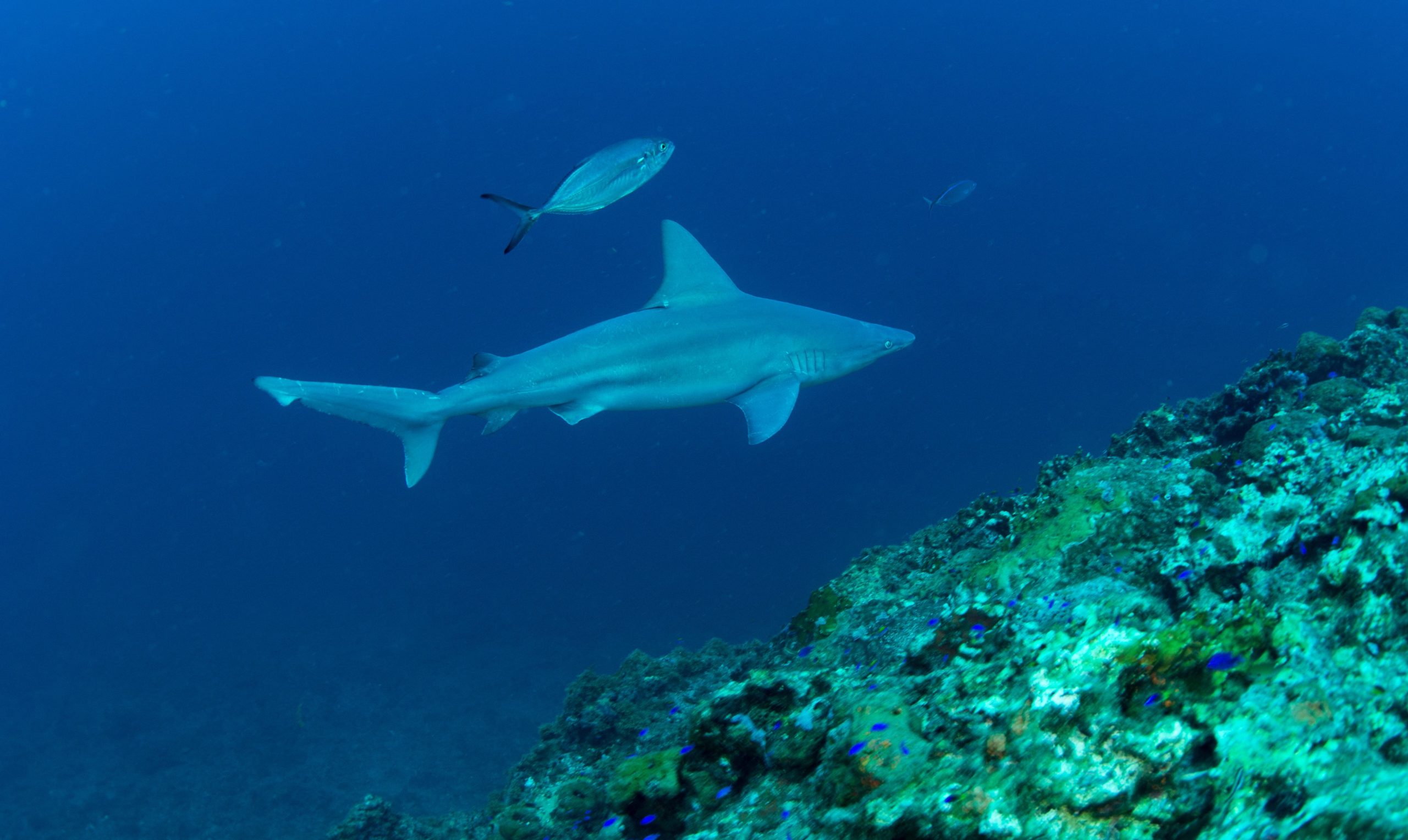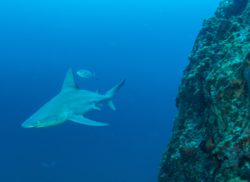
Sea Wonder: Sandbar Shark

Sandbar shark swimming over Stetson Bank in Flower Garden Banks National Marine Sanctuary. Photo: G.P. Schmahl/NOAA
The sandbar shark (Carcharhinus plumbeus) is the most abundant species of shark in the western Atlantic Ocean, though it can be quite elusive and is rarely spotted at the water’s surface. It is one of 60 species of requiem sharks, a family of sharks that includes tiger sharks, blacktip sharks, and spinner sharks. They are migratory, give birth to live young, and have long, torpedo-like bodies that give them agility and strength and make them ferocious predators.
Description
Sandbar sharks are one of the largest of open ocean sharks reaching lengths of seven feet and weigh between 100 and 200 pounds. Their backs are brown or gray and their bellies white, a biological camouflage known as countershading, which helps them blend into their environment and help them sneak up on their prey. Their bodies are long and torpedo-shaped, with a distinctly tall dorsal fin and a broadly rounded and short snout. Like many other sharks, their teeth are triangular and saw-like, which helps them catch and grip their prey.

Sandbar shark cruises through Flower Garden Banks National Marine Sanctuary. Photo: GP Schmahl/NOAA
Diet & Habitat
Sandbar sharks are opportunistic feeders, which means they aren’t at all picky, nor is their diet composed of a single prey type. They commonly eat small bony fish, smaller sharks and rays, and invertebrates like octopuses, shrimp, and crabs. They will feed during the day but are much more active at night, when their target prey are more likely to be active as well. They are agile and powerful hunters, and studies on their feeding behavior seems to show a higher overall success rate and a higher calorie diet for sandbar sharks than for closely related species of sharks. Larger sharks like bull sharks will hunt juvenile sandbar sharks, but they have few natural predators once they reach adulthood.
Sandbar sharks are found in nearly all parts of the world’s ocean in subtropical waters and are the most abundant shark species in the western Atlantic. In the United States, they are most common between Cape Cod, Massachusetts and Florida, and over into the Gulf of Mexico and the Caribbean. However, they are also seen in the Indo-Pacific region, including near the Hawaiian Islands. In the National Marine Sanctuary System, they live in or near all of the east coast sanctuaries and Hawaiian Islands Humpback Whale National Marine Sanctuary. As their name suggests, sandbar sharks generally prefer shallow inshore waters like sandbars, estuaries, bays, and harbors.
Like other requiem sharks, sandbar sharks migrate seasonally as environmental conditions and prey availability change. In the summer months, they travel to deeper waters where food is plentiful, and in the winter, they return to shallower, warmer waters. Females are solitary when they migrate whereas males form live schools of several dozen individuals.
Life History
Sandbar sharks mate in the summer and females are viviparous, meaning they support embryos with placenta and give birth to live young. Every other year, each female can give birth to as many as 13 pups. They give birth in shallow nursey grounds where pups are safer and generally out of range for larger sharks. The pups remain near or in their nursery for nine or 10 months before forming larger schools and migrating to deeper waters, repeating this pattern for about five years. Sandbar sharks grow slowly, reaching maturity at around 12 years old, which is nearly their whole lifespan of 15 to 21 years.
Threats & Conservation
Sandbar sharks are listed as “Vulnerable” by the International Union for Conservation of Nature (IUCN) Red List. Like most other sharks, overfishing and shark finning are threats to their population health. Sandbar sharks’ preference for coastal waters makes them an easy target for fishermen hunting them for their meat, oil, skin, and fins. The species has slow growth and reproduction rates, making them easily overfished. Decreased prey availability, especially as habitat is lost or their prey move due to a changing climate, also threatens their population.

A sandbar shark in Flower Garden Banks National Marine Sanctuary! In the Western Atlantic, these sharks range from New England to Brazil. Photo: G.P. Schmahl/NOAA
